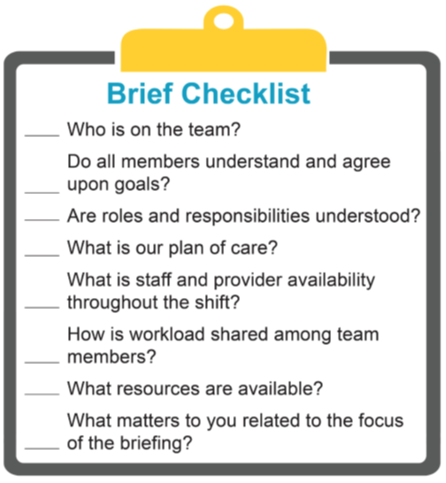Sharing the Care Plan: Brief
Briefs are a strategy for sharing care plans when leading a team. During a brief, which is sometimes referred to as a team meeting, the following information should be discussed:
- Team membership and roles—who is on the team and who is the designated team leader. If the patient has limited English proficiency then it is important to include the interpreter as part of the team.
- Clinical status of the team's patients—the current condition, diagnosis, and status of each patient assigned to the team
- The care plan for each of the team’s patients—what is to be accomplished, what are the expected outcomes, and who is to do it
- Issues affecting team operations—resources normally available that may be restricted during the current work period (i.e., shift)
Defining clear goals and a plan to achieve those goals is an important part of the brief, as is establishing clear roles and expectations for each team member. Successful teams measure their effectiveness in terms of how well they are performing against the established plan.1 The designated team leader usually conducts the brief, and team members actively participate.
When the team includes a patient or family caregiver with limited English proficiency, including the medical interpreter in relevant briefs will help fully support the patient and reduce the risk of unintended harm. The medical interpreter is best positioned to call attention to potential misunderstandings that affect the care plan and best able to ensure the patient can fully participate in decisions that affect them. A video illustrating this role is available:
LEP Safety: Success [6 min., 9 sec.]
As with a preflight checklist used in aviation, the team leader should cover the items on the Brief Checklist shown below (or one that is similar). Conducting a brief at the beginning of a shift or before a case provides a forum for communicating with other team members about the goals for each patient and the care plan to ensure patient safety.

Think about any briefs you have participated in during the past 2 weeks:
- Were all the tasks on this checklist addressed? If not, what was not done?
- If you were designing a brief checklist for your teams, what items would you include? When would the brief occur? Who would be expected to attend?
The TeamSTEPPS curriculum now includes a video-based simulation training to illustrate briefs, huddles, and debriefs and to encourage their effective use. Select to access this training.
Note
- Ryan S, Ward M, Vaughan D, Murray B, Zena M, O'Connor T, Nugent L, Patton D. Do safety briefings improve patient safety in the acute hospital setting? A systematic review. J Adv Nurs 2019 Oct;75(10):2085-2098. Accessed April 26, 2023.



